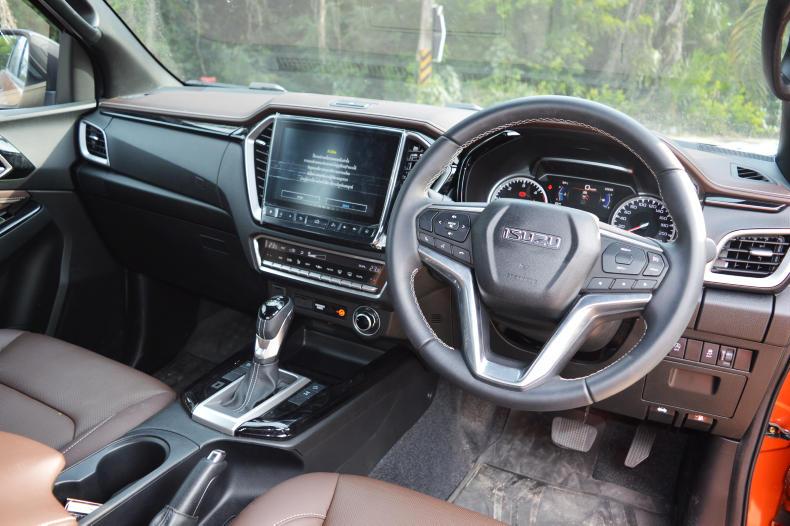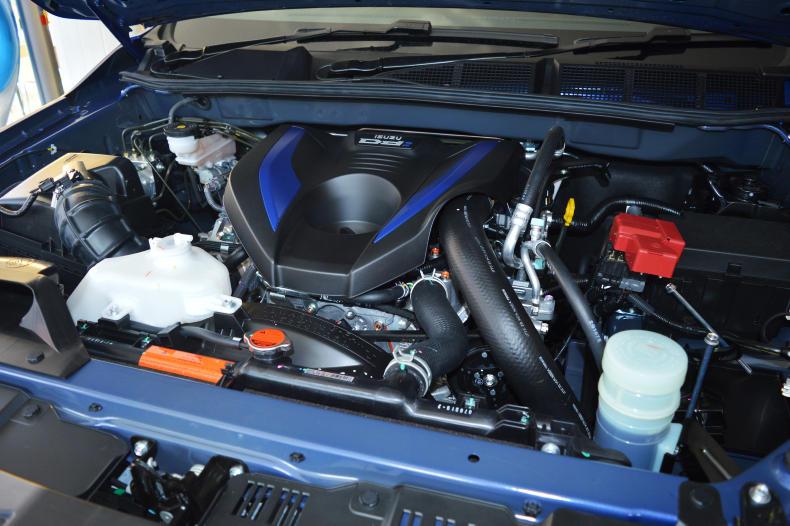The second-generation Isuzu D-Max due in September 2020 takes the pickup to the next level in terms of comfort and refinement. The new D-Max adds a host of new technology and a hugely improved ride to its traditional strengths of build quality and reliability.
For the past 30 years, Isuzu has teamed up with General Motors for pickup truck projects and its vehicles were therefore also rebadged as Opel, Holden and Chevrolet. However, for this latest pickup, Isuzu has partnered with Mazda. It will also be badged as the Mazda BT-50. It’s unclear, however, whether Mazda will mark a return to the Irish and European pickup market.

The dash layout is very modern, with a large central infotainment screen.
Isuzu D-Max 2020 details
We’ll start with the outside. Despite its vaguely familiar look, the 2020 D-Max has new body panels all-round. With its larger, boxier grille and thinner U-shaped LED headlights and LED lights incorporated into the rear tailgate, it now sports a more aggressive look.
The Isuzu also has a new interior and a new chassis, which is around 80kg lighter than the outgoing model. This has been achieved by using an aluminium prop shaft and higher tensile steel plates (980mPa), which Isuzu claims increases the chassis rigidity by 20%.

The new D-Max shares its design with a new Mazda BT-50.
Interior and technology
The D-Max cab is now the most advanced design in the pickup segment. It has a mixture of hard- and soft-touch leather, gigantic 9in touchscreen display, and hexagonal feature casings.
One thing carried forward from the previous generation is the abundance of storage space. There are small compartments for things like keys, wallets and phone directly in front of the gear lever, a flip down above the windscreen and two large compartments in the dashboard, a glovebox and a fairly modest-sized central cubby.
There is a wide range of technology on-board including Apple CarPlay and Android Auto, voice recognition and in terms of safety, it has cross-traffic alert and blind-spot monitoring, as well as hill start assist, brake assist and hill descent control, although it lacks autonomous braking.
Engine and driveline
For the Thai market, Isuzu offers two turbo-diesel engines on the 2020 D-Max – the 1.9-litre RZ42 (150hp/350Nm) and the recently updated 3.0-litre RJJ3 (190hp/450Nm) engine. However, the company may homologate different ECU settings for Europe on the 1.9 which could result in different power outputs, as this is marginally lower than the current model. The 3.0-litre is unlikely to make it to Europe.

The engine for the Irish market will be the 1.9 litre turbo-diesel unit similar to that fitted currently.
We don’t usually associate Isuzu with refinement, but there is no better word to describe the new engines.
The deep roars of old have been suppressed to a faint groan and they’re more responsive, with peak torque cutting in slightly sooner at just 1,800rpm on the 1.9 litre version.
There will be a choice of six-speed manual or six-speed automatic. Both versions impress, with the manual far smoother and with less throw.
The new RevTronic automatic provides almost seamless changes and there is an overdrive on the fifth and sixth gears to boost fuel efficiency – but still not quite to VW’s ZF standard.
Fuel economy is expected to be towards the best in the segment, according to Isuzu. The company has also stated that the chassis has been developed to house large lithium-ion batteries, meaning it could introduce hybrid or EV versions.
Ride and handling
The ride height is slightly higher than the previous model (there is now up to 240mm of ground clearance – one of the highest in the class) which provides great all-round vision but, surprisingly, it feels more responsive and connected to the road.
The steering wheel is smaller and turning requires less effort. There is relatively little body roll going into the corners which has been attributed to the 80kg lighter chassis and the new two-leaf suspension arrangement (reduced from three). As with engine noise, the amount of road noise perforating into the cab is minimal.
Off-road performance
Isuzu has introduced an electromagnetic diff-lock (the diff-lock has been absent from Isuzus since 2012) and the shift-on-the-fly system makes it quicker to shift between 2WD and 4WD. The wading depth has increased to 800mm – top of the class with the Ford Ranger.
Isuzu hasn’t confirmed the European-homologated weights yet, but it’s expected to retain the 1t payload and 3.5t towing capacity.
Availability
As with the Mitsubishi L200, bringing a vehicle into Europe is getting tougher these days because of the emissions and Isuzu says it will arrive into Irish dealerships in around September 2020 as they have to go for additional testing and homologation. They have said European models will be fitted with an AdBlue tank.
The second-generation Isuzu D-Max due in September 2020 takes the pickup to the next level in terms of comfort and refinement. The new D-Max adds a host of new technology and a hugely improved ride to its traditional strengths of build quality and reliability.
For the past 30 years, Isuzu has teamed up with General Motors for pickup truck projects and its vehicles were therefore also rebadged as Opel, Holden and Chevrolet. However, for this latest pickup, Isuzu has partnered with Mazda. It will also be badged as the Mazda BT-50. It’s unclear, however, whether Mazda will mark a return to the Irish and European pickup market.

The dash layout is very modern, with a large central infotainment screen.
Isuzu D-Max 2020 details
We’ll start with the outside. Despite its vaguely familiar look, the 2020 D-Max has new body panels all-round. With its larger, boxier grille and thinner U-shaped LED headlights and LED lights incorporated into the rear tailgate, it now sports a more aggressive look.
The Isuzu also has a new interior and a new chassis, which is around 80kg lighter than the outgoing model. This has been achieved by using an aluminium prop shaft and higher tensile steel plates (980mPa), which Isuzu claims increases the chassis rigidity by 20%.

The new D-Max shares its design with a new Mazda BT-50.
Interior and technology
The D-Max cab is now the most advanced design in the pickup segment. It has a mixture of hard- and soft-touch leather, gigantic 9in touchscreen display, and hexagonal feature casings.
One thing carried forward from the previous generation is the abundance of storage space. There are small compartments for things like keys, wallets and phone directly in front of the gear lever, a flip down above the windscreen and two large compartments in the dashboard, a glovebox and a fairly modest-sized central cubby.
There is a wide range of technology on-board including Apple CarPlay and Android Auto, voice recognition and in terms of safety, it has cross-traffic alert and blind-spot monitoring, as well as hill start assist, brake assist and hill descent control, although it lacks autonomous braking.
Engine and driveline
For the Thai market, Isuzu offers two turbo-diesel engines on the 2020 D-Max – the 1.9-litre RZ42 (150hp/350Nm) and the recently updated 3.0-litre RJJ3 (190hp/450Nm) engine. However, the company may homologate different ECU settings for Europe on the 1.9 which could result in different power outputs, as this is marginally lower than the current model. The 3.0-litre is unlikely to make it to Europe.

The engine for the Irish market will be the 1.9 litre turbo-diesel unit similar to that fitted currently.
We don’t usually associate Isuzu with refinement, but there is no better word to describe the new engines.
The deep roars of old have been suppressed to a faint groan and they’re more responsive, with peak torque cutting in slightly sooner at just 1,800rpm on the 1.9 litre version.
There will be a choice of six-speed manual or six-speed automatic. Both versions impress, with the manual far smoother and with less throw.
The new RevTronic automatic provides almost seamless changes and there is an overdrive on the fifth and sixth gears to boost fuel efficiency – but still not quite to VW’s ZF standard.
Fuel economy is expected to be towards the best in the segment, according to Isuzu. The company has also stated that the chassis has been developed to house large lithium-ion batteries, meaning it could introduce hybrid or EV versions.
Ride and handling
The ride height is slightly higher than the previous model (there is now up to 240mm of ground clearance – one of the highest in the class) which provides great all-round vision but, surprisingly, it feels more responsive and connected to the road.
The steering wheel is smaller and turning requires less effort. There is relatively little body roll going into the corners which has been attributed to the 80kg lighter chassis and the new two-leaf suspension arrangement (reduced from three). As with engine noise, the amount of road noise perforating into the cab is minimal.
Off-road performance
Isuzu has introduced an electromagnetic diff-lock (the diff-lock has been absent from Isuzus since 2012) and the shift-on-the-fly system makes it quicker to shift between 2WD and 4WD. The wading depth has increased to 800mm – top of the class with the Ford Ranger.
Isuzu hasn’t confirmed the European-homologated weights yet, but it’s expected to retain the 1t payload and 3.5t towing capacity.
Availability
As with the Mitsubishi L200, bringing a vehicle into Europe is getting tougher these days because of the emissions and Isuzu says it will arrive into Irish dealerships in around September 2020 as they have to go for additional testing and homologation. They have said European models will be fitted with an AdBlue tank.









 This is a subscriber-only article
This is a subscriber-only article










SHARING OPTIONS: